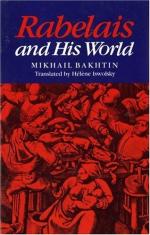
|
| Name: _________________________ | Period: ___________________ |
This quiz consists of 5 multiple choice and 5 short answer questions through Chapter 16, Chapter 7 - Rabelais' Images & His Time.
Multiple Choice Questions
1. "The Treatise of Garcia of Toledo," which Bakhtin cites, is notable for:
(a) Its retelling of ancient myths and fables.
(b) Its simple philosophy of religious asceticism.
(c) Its disregard for the festive tradition.
(d) Its portrayal of the gluttony of the Pope.
2. What is a "marketplace spectacle"?
(a) The mundane goings-on of a typical French Renaissance marketplace.
(b) A series of booths dedicated solely to bilking customers out of their money.
(c) Specifically the public whipping of a criminal in the center of the marketplace.
(d) A theatrical production arranged atop a platform in the center of the marketplace.
3. According to Bakhtin, Carnival was the true symbol and incarnation of:
(a) The natural world.
(b) The sanctity of the Church.
(c) The folk festival.
(d) The power of the monarchy.
4. In grotesque realism, the body is most often represented as:
(a) Several separate units fighting with each other for superiority.
(b) Subordinate to the higher functions of the brain.
(c) A whole unit, interior merged with exterior.
(d) A faulty copy of the Divine.
5. Why does Bakhtin consider oaths, curses, and profanities elements of freedom?
(a) Slaves are prohibited from using such forms of speech.
(b) They are contrary to official modes of speech.
(c) A person can form any sound into a curse or profanity.
(d) Populist uprisings often have profanities and oaths in their declarations.
Short Answer Questions
1. What does Rabelais associate closely with the underworld?
2. The core images of the prologue of _Gargantua_ are:
3. What does Bakhtin consider the most indispensable element of folk culture?
4. Bakhtin thinks that life is:
5. Gargamelle gives birth to Gargantua as a result of:
|
This section contains 335 words (approx. 2 pages at 300 words per page) |

|




